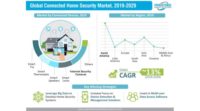Often you hear the terms connected home and smart home used interchangeably, but they are not the same thing. At least not yet. What is the difference between the smart home and the connected home today? The degree of “connectivity.”
The connected home is all the rage in the residential security space, and more and more security dealers are jumping on board the trend, relying on providers such as Alarm.com, Alula, Honeywell, Telguard and others that have curated ecosystems designed to make the security system work together with other connected products like lights, locks, thermostats, garage doors, etc.
For many security dealers the connected home is the natural outgrowth of interactive services — the capability that is now table stakes for homeowners to be able to interact with their security system remotely from a smartphone or tablet, to turn it on or off or to program it. Many customers come to the connected home through other “smart” devices they have bought themselves at a retail store or through an online source. Whether a Nest thermostat or an Amazon Alexa or Kwikset lock, these devices are designed to talk to other devices, and when combined with a connected security system provide a combined value to the consumer that provides peace of mind, comfort and convenience.
According to the research firm Parks Associates, nearly 40 percent of security dealers that offer interactive services today report that half or more of their sales now include at least one smart home device, which is testament to the growing consumer demand. Dealers are listening. The Parks study also found that more than 90 percent of U.S. security dealers offer some form of interactive service, and 75 percent of security sales overall include at least one smart home device.
True smart homes have actually been around much longer than connected homes. These are the full Monty of the connected world, and have not until recently intersected much with the average security dealer. Companies like Crestron and Control4 are the kings of this world and their dealers consider security only a small part of their universe. True “smart” homes feature connectivity farther outside the sphere of most security companies, including entertainment systems, smart shades, smart appliances and audio/visual, and they are generally much more involved — and expensive — than connected security systems.
However, smart home dealers and companies report changes in their space that have been influenced by the connected consumer trend. It turns out those customers like Alexa, too. And they also very much want to take advantage of the proliferating and relatively inexpensive products coming out of the connected security space. Accordingly, smart home dealers are seeing more attachment of security systems to their smart home ecosystems than ever. And some in the security space are anticipating more of this in the future — Telguard for example is deliberately setting up its offering to work with any system, with the idea that the security system will eventually become one spoke on the wheel of the smart home.
So what is the real difference between a connected home and a smart home? Really it is more of a continuum at this point. For what most homeowners want right now, the security dealer is in a prime position to deliver that connection. When the customer wants to incorporate more items that are not as much a part of the security world right now, such as A/V, then it becomes the purview of the smart home dealer. However, as the Internet of Things marches on, and technology continues get more available and affordable, these two words — and worlds — may become more and more interchangeable. Watch this space. — By Karyn Hodgson, SDM Managing Editor




